
Frederick III was Holy Roman Emperor from 1452 until his death. He was the fourth king and first emperor of the House of Habsburg. He was the penultimate emperor to be crowned by the pope, and the last to be crowned in Rome.

Louis IV, called the Bavarian, of the house of Wittelsbach, was King of the Romans from 1314, King of Italy from 1327, and Holy Roman Emperor from 1328.

Conrad III of the Hohenstaufen dynasty was from 1116 to 1120 Duke of Franconia, from 1127 to 1135 anti-king of his predecessor Lothair III and from 1138 until his death in 1152 king in the Holy Roman Empire. He was the son of Duke Frederick I of Swabia and Agnes, a daughter of the Salian Emperor Henry IV.
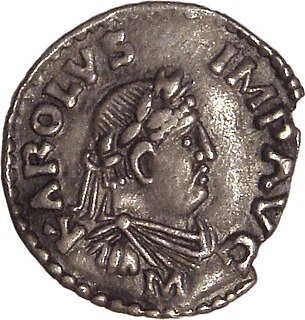
The Holy Roman Emperor, originally and officially the Emperor of the Romans during the Middle Ages, and also known as the German-Roman Emperor since the early modern period, was the ruler and head of state of the Holy Roman Empire. The title was held in conjunction with the title of king of Italy from the 8th to the 16th century, and, almost without interruption, with the title of king of Germany throughout the 12th to 18th centuries.

William I or Wilhelm I was King of Prussia from 2 January 1861 and German Emperor from 18 January 1871 until his death in 1888. A member of the House of Hohenzollern, he was the first head of state of a united Germany. He was de facto head of state of Prussia from 1858, when he became regent for his brother Frederick William IV, whose death three years later would make him king.
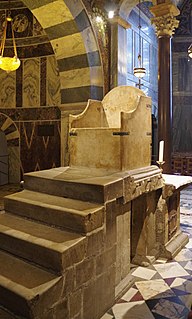
King of the Romans was the title used by the king of Germany following his election by the princes from the reign of Henry II onward. The title predominantly amounted to being the emperor of the Holy Roman Empire, a title long dependent upon coronation by the pope.
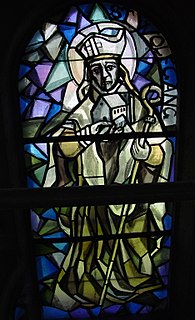
Saint Wolfgang of Regensburg was bishop of Regensburg in Bavaria from Christmas 972 until his death. He is a saint of the Catholic and Eastern Orthodox churches. He is regarded as one of the three great German saints of the 10th century, the other two being Saint Ulrich of Augsburg and Saint Conrad of Constance. Towards the end of his life Wolfgang withdrew as a hermit to a solitary spot, in the Salzkammergut region of Upper Austria. Soon after Wolfgang's death many churches chose him as their patron saint, and various towns were named after him.

Prince Albert William Henry of Prussia was a younger brother of German Emperor William II and a Prince of Prussia. He was also a grandson of Queen Victoria. A career naval officer, he held various commands in the Imperial German Navy and eventually rose to the rank of Grand Admiral and Generalinspekteur der Marine.
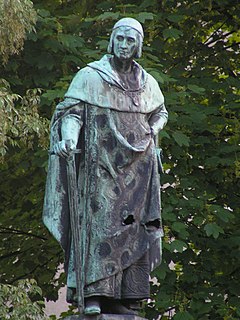
Baldwin of Luxembourg was the Archbishop- Elector of Trier and Archchancellor of Burgundy from 1307 to his death. From 1328 to 1336, he was the diocesan administrator of the archdiocese of Mainz and from 1331 to 1337 of those of Worms and Speyer. He was one of the most important German prelates of his age.
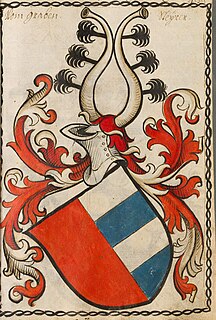
Andreas von Graben zu Sommeregg was a Carinthian knight and nobleman residing at Sommeregg Castle. He served as a burgrave and castellan governor in the Ortenburg estates, held by the Counts of Celje until 1456.

Count Heinrich II of Virneburg was Archbishop of Cologne from 1304 to his death in 1332.
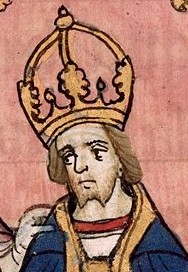
Henry VII, also known as Henry of Luxembourg, was Count of Luxembourg, King of Germany from 1308 and Holy Roman Emperor from 1312. He was the first emperor of the House of Luxembourg. During his brief career he reinvigorated the imperial cause in Italy, which was racked with the partisan struggles between the divided Guelf and Ghibelline factions, and inspired the praise of Dino Compagni and Dante Alighieri. He was the first emperor since the death of Frederick II in 1250, ending the Great Interregnum of the Holy Roman Empire; however, his premature death threatened to undo his life's work. His son, John of Bohemia, failed to be elected as his successor, and there was briefly another anti-king, Frederick the Fair, contesting the rule of Louis IV.

Henry V was King of Germany and Holy Roman Emperor, as the fourth and last ruler of the Salian dynasty. He was made co-ruler by his father, Henry IV, in 1098.

Henry III, called the Black or the Pious, was Holy Roman Emperor from 1046 until his death in 1056. A member of the Salian dynasty, he was the eldest son of Conrad II and Gisela of Swabia.

Johann III, Count of Sponheim-Starkenburg, the Older, reigned over the County of Sponheim for 67 years. He also received many epithets such as "the Noble" and, because of his declining vision, "the Blind".

The elector of Trier was one of the prince-electors of the Holy Roman Empire and, in his capacity as archbishop, administered the archdiocese of Trier. The territories of the electorate and the archdiocese were not, however, equivalent.

The Sacramentary of Henry II, also called the Regensburg Sacramentary, is a manuscript of liturgical texts, which was created in Regensburg at the order of Emperor Henry II. It is among the most significant works of Ottonian illumination. The manuscript was gifted to Bamberg Cathedral by Henry II, was part of the Cathedral treasury until 1803 when it became part of the Bavarian State Library as a result of Secularisation. It remains there today, stored under the inventory number clm 4456. It is modelled on the Codex Aureus of St. Emmeram donated by Charles the Bald in 870.

An uprising of the Guelph faction in Milan led by Guido della Torre on 12 February 1311 was crushed by the troops of king Henry VII still on the same day.
The Codex Hersfeldensis was a manuscript from the Early Middle Ages. Written between 830 and 850, the codex was found in Hersfeld Abbey in the first half of the 15th century. The codex was brought to Italy by Enoch of Ascoli in 1455, where it was divided up and copied. The original has since been lost. The Codex Hersfeldensis is considered to be the original source for the surviving manuscripts of the Opera Minora – the shorter works of Tacitus, including the Germania.

Maximilian I was Holy Roman Emperor from 1508 until his death.



















